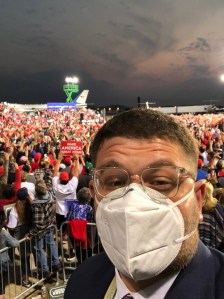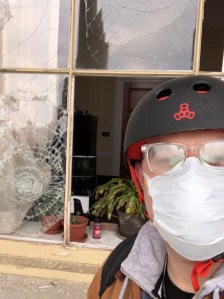I have been in the absolute thick of it. As a campaign trail reporter and White House correspondent throughout Donald Trump’s rise and presidency, I had a front row seat to the tsunami of paranoia, racism, and political violence that now threatens to consume American society as we knew it. The experience brought me back to TPM after nearly a decade away.
As we are in the final stretch of our membership drive, I’d like to tell you the story of my back-and-forth journey with TPM and why I hope you will join me here.
The best news coverage is, at its heart, confrontational. When dangerous situations arise, reporters — both literally and figuratively — run to the scene of the action. Even in less volatile scenarios, taking on those in power by investigating their life and work or asking the toughest questions we can is a fundamental part of what we do. However, in recent years, original, confrontational journalism has become all too rare.
I first encountered TPM as a college student in the mid 2000s. It was an era defined by a court and GOP that actively resisted popular democracy. The end result was a president who launched a series of brutal foreign wars on false pretenses. On the media front, the internet explosion coupled with corporate consolidation helped contribute to the erosion of the local news ecosystem, particularly alt-weeklies like the Village Voice that were almost completely silenced.
I wanted to be a reporter and earnestly believed it was a way to make a positive impact. I also knew, as the country hurtled deeper into war, that something was wrong. I was eager to get involved and searching for media that actually rose to the occasion. Naturally, in 2004, when the late, legendary Texas newspaper columnist Molly Ivins came to speak at my college, I eagerly jumped at the chance to attend.
For those who don’t know her, Ivins was perhaps the pre-eminent chronicler of George W. Bush during his days as Texas governor. She was uniquely aware of his excesses and weaknesses and brought this unsparing understanding to her coverage of the White House. I rushed up to Ivins after the event to ask what I hoped was a smart question: which “blog” should I be reading? Back then, as quaint and ridiculous as this seems, blogs were seen as cutting edge. I hoped Ivins would be impressed by my query, but I also truly needed an answer. Ivins had one recommendation: a guy named “Joshua Micah Marshall” and his site, Talking Points Memo.
I have read TPM ever since. The site had the confrontational approach I felt was lacking elsewhere. Just as importantly, TPM never lost its sense of humor when covering corruption and political chicanery. TPM has never been afraid to wallow in the worst of our politics, but it does so while maintaining high spirits, and, ultimately, hope.
TPM’s aggressive, honest, and irreverent ethos drew me in. After an early career that included work for some of the last gasps of some late, great local papers, I finally had a chance to join the team myself in early 2013. My first work for TPM included relentless coverage of the New Jersey “Bridgegate” scandal, a couple of campaign meltdowns, a memorable trip to Canada, strolls down congressional corruption memory lane, keeping an eye on the far right, and some of the earliest indications Donald Trump was about to blow everything up.

I left TPM after about a year because I had opportunities to go to larger organizations that could put me out on the campaign trail. I even made it into the White House. However, getting inside the Washington press corps as the nation was gripped by Trump, a pandemic, and repeated shocks of political violence helped me see how most news organizations were ill-equipped to grapple with our new national reality.
Throughout the Trump era, DC’s political and media institutions have propped up an overhyped center. Hours of TV and miles of column inches are devoted to supposedly more traditional conservatives that are, we are told, so very different from Trump. It’s a worldview that ignores how much Trump was firmly rooted in decades of xenophobia and militancy that was encouraged by the institutional right and the GOP. Most importantly, it also denies how much his MAGA movement has fully taken over the party. It’s the kind of logic that fuels coverage treating the Jan. 6 plot as the product of a small cadre of hardcore Trumpers while largely ignoring the fact over a quarter of the U.S. Congress, including more than half of Republicans in the House — voted against a free and fair election.
To me, a lot of the most crucial stories are happening at what might have once been considered the fringes of our politics. This includes the left, where a younger and more diverse electorate has brought progressive and socialist politics into the mainstream. On the right, conspiracy theorists, grifters, and extremists who once operated on the margins have moved much closer to the center of the action and halls of power.
After a half decade working for a large corporation, I struck out on my own and focused on doing original investigative work chronicling these figures. I was able to do many stories that I am incredibly proud of, but I also faced persistent legal threats of the sort that have become increasingly common in the current media environment and made working on my own untenable. Luckily for me, in the years that I was away from TPM, the site grew to a place where it was able to support original investigative work. When I saw they were hiring for a role in that space, I jumped at the chance to get back in.
In just over a year back at TPM, I have been able to help break stories that exposed the inner workings of the Jan. 6 plot and the institutional Republican Party’s role in it. We broke the news of the central credit card scam that former congressman George Santos was ultimately indicted for. And, time and time again, we have published exclusives illustrating the deep ties between Washington Republicans and elements of the global far right, including neo-Nazis.
This work takes time — and spine. TPM has been able to provide the kind of legal and logistical support that enables these crucial stories, but, more than that, the reason we are able to do this work so well here is that it is a fundamental part of this site’s DNA.
As the former president has launched racist and — at times — violent attacks on his rivals while engaging in unprecedented criminality, including efforts to undermine democracy, the phrase “unprecedented” has become a buzzword for many pundits and media outlets. However, here at TPM, we know the roots of this dangerous moment were planted long ago. The violent elements of the current MAGA movement have their most direct forebears in the racist conspiracies of the Tea Party and the modern militia movement that I covered during my first stint at TPM. We have been on these stories — and recognized their importance — from the beginning.

While others seem reluctant to call this moment what it is or confront it aggressively, TPM has always been a champion of the kind of confrontational journalism that is able to shine a light and ring the alarm on the darkest elements of our politics. After making my way through the media industry, I adamantly believe that a major part of what enables TPM to do this is our unique business model.
The best confrontational journalism involves having an independent voice and true editorial independence. We can’t count on big companies to stand up and keep it real when things are getting weird and bad. An unconventional moment like this one requires unconventional original journalism. This is being called a media “apocalypse,” but TPM has been able to stay alive and thriving because we are not reliant on corporations or their advertising.
Over 90 percent of our funding comes from our readers. You make it possible for TPM to do aggressive and independent investigative reporting.
With just 15 employees, we can’t entirely fill the void left by the collapse of the alt weeklies. However, we hope that our work has proved us to be a worthy heir to their swashbuckling and muckracking spirit.
Our annual membership drive is in full swing and it is vital to keeping the site going. I hope you will consider signing up to join our community. If you’re already a member, perhaps you will consider taking this relationship to the next level and supporting our journalism fund.
I could not do what I do away from TPM — and we can’t do it without you. Thanks so much for your support.






